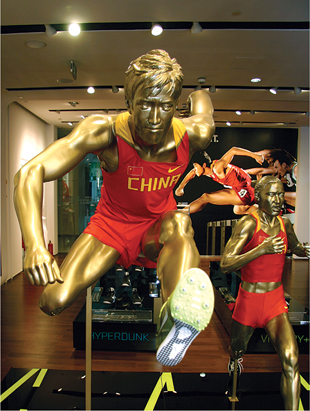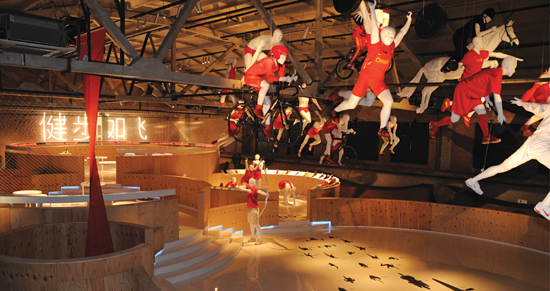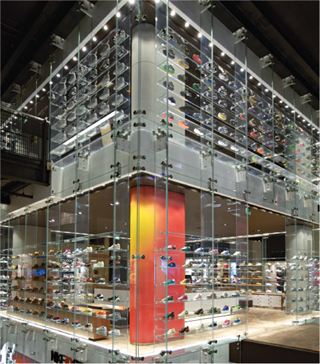BE INSPIRED BY THE PAST TO CREATE A RICH AND SOULFUL FUTURE.
I get inspired by getting outside. Meeting new people, traveling to new places, and immersing myself in new experiences is essential to finding inspiration. Spending time in different cities throughout the world allows me access to different cultures and approaches to design. These diverse experiences help to serve as catalysts during the creative process and ensure that the design work represents a world beyond just my daily experiences.
Cataloging and documenting these trips is key to getting the most out of them. And technology has made that process easier, not only to gather but also to share. What used to require stacks of paper, magazines, slides, videos, and so on now fills a multigigabyte hard drive. The hard drive becomes an inventory of inspiration that you can continually draw upon.
Besides drawing inspiration from what is new and emerging, I find that having an understanding and appreciation for design history and the design movements of the past is just as essential to me. So, you could say I have two buckets of inspiration: past and present. These two visual catalogs represent fashion, architecture, print, brand identity, film, and other design mediums. Having all of this great reference material is a good starting point, but it’s what you do with it that counts.

We hired sculptors to add to the body scan forms and bring out all the unique characteristics of the athlete, whether it was Kobe Bryant or LeBron James, and we got a life-size, realistic-looking sculpture. Then we could copy and create as many Kobes or LeBrons as we wanted. Instead of something more typical, like photography, this allowed us to present the athlete in a way that consumers could interact with and compare themselves to.
Drawing upon the past and the present for design inspiration, and then applying them both in the design process, can lead to some of the most interesting innovations. I like to think about it as presenting the past in a modern context or applying a contemporary motif to a timeless form. It’s really about that juxtaposition; that mashup. It’s the relationship between the past and present, which ultimately leads to something inspirational and innovative.
This approach can work whether I’m designing a uniform for the Brazilian national football team, creating a new environment devoted to customization, or designing a logo for an athlete. This provides the consumer (or the athlete) with a design solution that has hints of familiarity but is undeniably contemporary in its form and function. It’s an approach that allows us to remain true to our athletic heritage while reshaping the definition of sport—the future of sport.
We placed the life-sized realistic-looking sculptures in China, Europe, and in the U.S. Imagine the difference for the consumer, used to the traditional department store mannequin, being able to see an extremely realistic, dynamic version of Liu Xiang sprinting past you.

In terms of global reach and how many different aspects and consumer experiences existed with a project, one of the biggest initiatives we’ve taken on is designing for the Beijing 2008 Olympics. Every four years, you need to bring something fresh to the market. We’re always trying to bring the athlete closer to the consumer—up close and personal, if you will.
For the Olympics, we thought about how to take that idea of the heroic sculpture, but to do it based on a specific moment at the games. How do you create that in a unique and memorable way, and let that anchor some of these consumer experiences that we do?
We worked with a team in Los Angeles and did body scans of the athletes. From the body scans, we created a three-dimensional print of each athlete, creating a form, like when Liu Xiang goes over a hurdle or Asafa Powell explodes out of the blocks.
That’s just a sliver of one of the many things we did for the Beijing Games, combining all design mediums around that initiative—photography, print, consumer experiences, and so on.
The idea of customizing your own shoe with Nike ID has been out there for some time, but the reality is that only a small segment of consumers actually knew what Nike ID was. The more we thought about it, the more it seemed that in order to spark this idea of customization, we needed to bring consumers into a 3-D experience.
We started to play around with this idea of a physical design studio—Nike ID Studio—that was a celebration of the creativity people have within themselves. The inspiration comes from the product design. We integrated those elements into the architecture and the visual language of the spaces, essentially coding the spaces.
We looked back to the craftsmanship of seventeenth- and eighteenth-century artisans—burning patterns into wood, and then filling those patterns with heated gold, creating a beautiful design. Taking inspiration from that, we created athlete line-work collages and burned them into table surfaces using some of the Old World techniques. Being inspired by some of the techniques from the past allowed us to touch the romance and edge of what those artists did. Drawing from those practices, but putting them through our filter, we ended up with this beautiful, modern aesthetic that was really soulful and inspirational. It was inspirational to people who love footwear and people who just wanted to be in a creative space.
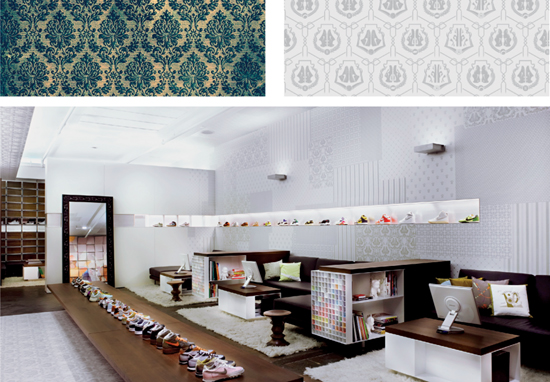
We looked at Victorian wallpaper and how ornate and detailed it was, and said, “What if we did elaborate wallpaper, but it was made up entirely of different iconic shoe designs?” So, at first glance, you might not get it, but the more time you spend within the space, the more details you pick up.
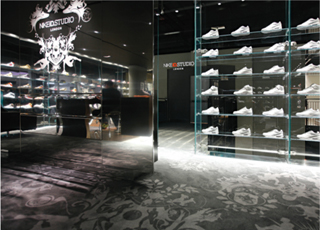
For the ID London cube, we wanted the product itself to become an element of the architecture. This two-story glass cube we created allowed us to display more than 1,000 pairs of footwear. It creates a huge visual impact from outside, and upon entering the cube, it helps deliver a complete product-customization experience.
Many of the things within the Nike ID London cube experience celebrate innovation and technology, but we surrounded that experience with handcrafted art and patterns. Looking back, some of the designs created by Old World craftsmen actually feel more contemporary than designs that use the latest programs and applications. It’s great that we have all this technology that enables the design process, but it’s how it’s used that’s important. In this case, technology simply allowed us to refine and enhance design methods that have been around for ages.
Our first Nike ID studio was an intimate 400 square-foot (37 m2) space at 255 Elizabeth Street in New York City, which was followed by a second one in Niketown, New York. But, ultimately, this concept really came to life in London. From a pure environmental design standpoint, it’s created a lot of buzz within the design community. But the reality is, if we’re receiving a lot of accolades but not delivering a rich and compelling experience to the consumer, who really cares?
In all three of these instances, there was very little compromise in terms of going from inspiration to reality. It’s taking the best of what we do—providing product innovation for athletes—and presenting it through an inspirational and dynamic expression.

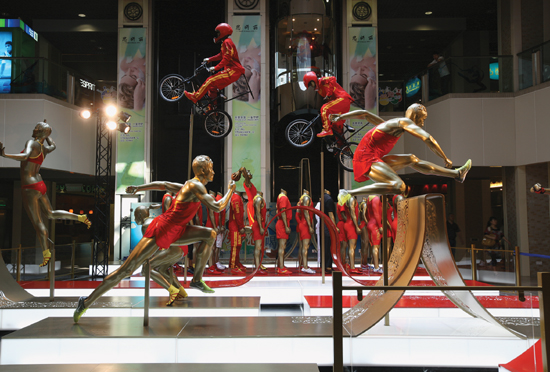
 NIKE
NIKE